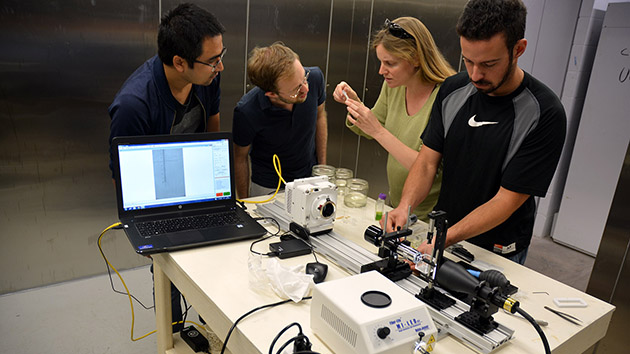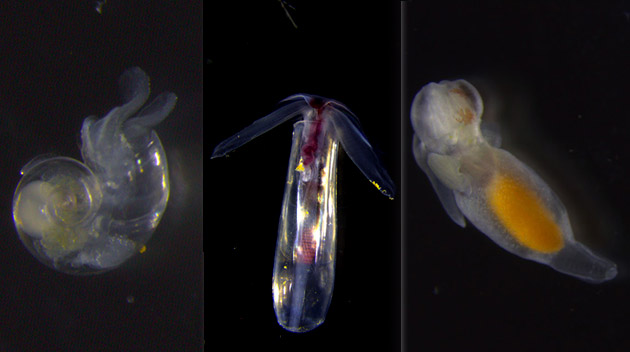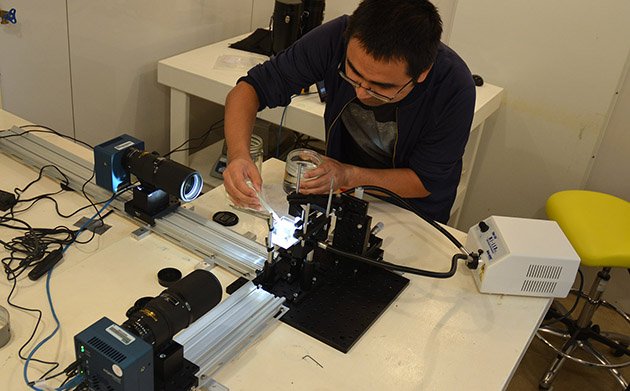Lights, Cameras… Sea Butterflies

Researchers work in one of the new BIOS environmental rooms to study the movements of sea butterflies. They include (from left) Ferhat Karakas, a graduate student at the University of South Florida interested in fluid mechanics; David Murphy, a professor who studies biological, ecological and environmental fluid dynamics at the University of South Florida, Amy Maas, an oceanographer at BIOS; and Joseph Bello, an undergraduate student at the University of South Florida.
Sea butterflies are tiny marine snails but, instead of a traditional foot, they have a pair of wing-like appendages. These propel them on their daily migration from the sea surface, where they feed, down to deeper, darker waters to hide from predators.
“They seem to flap their ‘wings’ to ‘fly’ through the water in the same way that insects fly through the air,” said Amy Maas, a biologist at BIOS.

The shells of sea butterflies, or pteropods, come in different shapes and sizes: spirals for Helicinoides inflatus, long columns on Cuverina columella, and non-spiral shapes, such as for Pneumodermopsis. All of these live in waters offshore Bermuda, though sea butterflies are found throughout the world, including polar waters. Ocean acidification makes it difficult for the organisms to craft the molecular building blocks they use to construct their shells, causing them to break apart. Photos by Amy Maas
However, because these tiny, fragile organisms are difficult to study, little is known about their swimming mechanics, or the role that swimming plays in their ecology. To explore these ideas, Maas and researcher David Murphy from the University of South Florida began a collaborative project at BIOS this May to measure and plot the movements (known as swimming kinematics) of a variety of sea butterflies, as well as to study how water moves around them (called a flow signature).
Researchers have studied the swimming kinematics and flow signatures of many marine organisms, from manatees and sharks to scallops and juvenile herring. Their work helps to increase understanding of how these creatures travel through the ocean. Maas said sea butterflies could also influence robotic design.
“We would like to know if the swimming dynamics models based on the sea butterflies’ movement could be used to develop robots that can ‘fly’ through both water and air,” she said.
Understanding how they swim also interests her because these organisms are in peril. Sea butterflies, also known as pteropods, vary in shape and size, with some as large as peppercorns. They spend their lives swimming in open water and serve as a primary food source for larger marine life, including salmon, sharks, and whales. However, the changing ocean chemistry caused by burning fossil fuels reduces the availability of the mineral the organisms use to build their shells, causing slower shell growth and rendering them weak and fragile.
“From studies like this we hope to learn if climate change influences the swimming capacity of these critters,” Maas said.

While at BIOS, Ferhat Karakas, a graduate student at the University of South Florida, advanced his understanding of the fluid dynamics of swimming by studying the movements of sea butterflies (also known as pteropods) with shells of different sizes and shapes.
To conduct their initial studies, funded by grants from BIOS and the University of South Florida, Maas and Murphy (and several students) used two recently acquired and developed camera systems at BIOS. They carried out the work in the Institute’s newly built environmental rooms, which allow the researchers to work in temperature-controlled environments suited for the tiny organisms they study.
One system uses two cameras focused on a single region on the sea butterfly’s shell to track its movement through time and space. The second, single-camera system relies on a tank seeded with tiny particles (either phytoplankton or titanium beads) to determine how water flows around the organisms as they swim. As the sea butterflies move, the swirling patterns of the particles during their journey show how their wings generate lift, and helped researchers determine how the organisms use and conserve energy.
